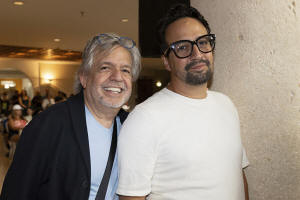Lin-Manuel Miranda gave millions to Puerto Rican artists after Hurricane
Maria. He's pledging more
[October 01, 2025]
By GABRIELA AOUN ANGUEIRA
SAN JUAN, Puerto Rico (AP) — As Hurricane Maria roared over Puerto Rico
in September 2017, Marena Pérez and Aureo Andino hunkered down inside
their ballet studio. The couple never imagined that they, their daughter
and Pérez’s parents would live there for three months, sleeping on
pullout couches and relying on a gas generator.
The Category 4 hurricane flooded Pérez and Andino’s house with 4 feet of
water. Unable to return home, the founders and directors of Mauro Ballet
decided to open their doors to the community, teaching a free dance
class each afternoon.
“It became an oasis for dancers in Puerto Rico,” said Andino. But Mauro
Ballet still struggled — the dance company didn’t make money for 18
months.
It survived in part thanks to support from the Flamboyan Arts Fund, a
$22 million initiative propelled by Lin-Manuel Miranda and his family,
and funded mainly by money raised during a 2019 run of Miranda’s
acclaimed Broadway musical “Hamilton” in San Juan.
“Artists always get left out of the conversation,” Miranda, an
award-winning writer and performer whose parents were raised in Puerto
Rico, told The Associated Press. “We wanted to make sure they were not
forgotten in relief efforts.”
Instead of being forgotten, artists assumed essential roles, helping the
archipelago grieve from Maria’s devastation and articulating the
challenges Puerto Ricans faced.

“You can use the arts in so many ways to express your feelings, and to
heal,” said Pérez.
The Flamboyan Arts Fund has supported 110 Puerto Rican arts
organizations and 900 artists. Now the Miranda family and the D.C.-based
Flamboyan Foundation are committing an additional $10 million to Puerto
Rican arts and culture.
Despite federal funding cuts to arts and humanities, the new phase of
giving is meant to go beyond emergency relief — helping arts and culture
thrive and even become an economic driver for the archipelago.
“It just gives us too much back,” said Miranda, 45. “If you have ever
enjoyed the work that comes from this island and its descendants, to
invest in that future is important.”
Healing arts
Hurricane Maria led to an estimated nearly 3,000 deaths, most of them
related to the lack of power, clean water, and other services. Damages
surpassed $115 billion, and power outages lasted 11 months in some
places.
The destruction was so vast that Marianne Ramírez Aponte, executive
director and chief curator of the Museo de Arte Contemporáneo in San
Juan, worried the cultural sector could not overcome it.
What happened instead was “quite the opposite,” she said.
Arts groups opened their spaces as relief hubs and activated mutual aid
networks. “Cultural brigades” deployed their talents to comfort and
entertain.
“It was a horrible situation, but we were able to prove the importance
of art in the social process,” said Yari Helfeld, executive director of
the community theater company Y No Había Luz.
Helfeld got requests to perform from isolated communities in Puerto
Rico’s central mountains just weeks after the storm. She was surprised
to be asked for theater when people still struggled to access food and
water.
“They said, ‘You’re helping heal the spirit,’” said Helfeld.

Artists could also channel and contextualize the public frustration over
the U.S. territory’s slow recovery. Maria exposed the consequences of
what many Puerto Ricans still consider a colonial relationship with the
U.S.
Help from federal and local government came slowly and sometimes not at
all. Federally imposed austerity measures tied to massive public debt
exacerbated economic woes. Power outages disrupted daily life.
[to top of second column]
|

Lin-Manuel Miranda, right, poses with his father, Luis A. Miranda
Jr., during the closing event of the Flamboyan Arts Fund in San
Juan, Puerto Rico, Saturday, Sept. 13, 2025. (AP Photo/Alejandro
Granadillo)
 After over 120,000 Puerto Ricans
left the archipelago in search of stability, a wave of U.S. and
foreign investors and remote workers descended, worsening
displacement and prices.
Poetry, paintings and performances confronting these realities
helped people “process intellectually, emotionally, what had
happened to the country,” said Ramírez Aponte.
Artists like Rayze Michelle Ostolaza Oquendo expressed the
territory's hopes and disappointments.
“I have a dream, and it’s simple: to be allowed to be from here, to
die on this land and whistle like the coquí, it’s not much to ask,"
she wrote in her 2024 poem “Ser Puertorriqueño,” or “To Be Puerto
Rican.”
A new phase
Money from the Flamboyan Arts Fund supported fellowships for
Ostolaza Oquendo and other writers. It helped pay studio rent and
wages, and restored a flooded wing of the Museo de Arte de Puerto
Rico.
The funding bolstered the sector’s resilience, equipping museums and
cultural centers with solar panels and batteries, emergency food and
first-aid kits to continue arts programming and support communities
after disasters. A sweeping effort to digitize 1,200 art pieces and
artifacts across the archipelago became a lifeline during the
COVID-19 pandemic, when museums could continue their programming
online.
The Miranda Family Fund and the Flamboyan Foundation planned to wind
down the project after granting all $22 million. Instead, they're
committing more and encouraging donors to join them.
“Because it’s been successful, but mostly because it’s needed still,
we’ve decided to continue it,” said Kristin Ehrgood, who co-founded
the Flamboyan Foundation with her husband Vadim Nikitine and serves
as its CEO. “Funding for arts and arts organizations continues to
decline.”

President Donald Trump has proposed eliminating the National
Endowment for the Arts, National Endowment for the Humanities, and
the Institute of Museum and Library Services, all of which support
Puerto Rican institutions. The Puerto Rico Humanities Council saw
its 2025 general operating grant cut by over half.
Ehrgood said the two families want the new funds to also go beyond
emergency relief, amplifying Puerto Rico’s talent and even
stimulating its economy.
This month, Latin music superstar and 2026 Super Bowl Halftime Show
headlinerBad Bunny completed a 31-concert residency in San Juan
estimated to have injected $733 million into the local economy on
top of a multiyear Amazon Music partnership that will support local
causes.
His newest album, “Debí Tirar Más Fotos” is a celebration of his
homeland that showcases local musicians and beloved musical genre
like plena and salsa. It also calls out the territory’s political
status and fight against displacement in songs like “Lo Que Le Pasó
a Hawaii,” or “What Happened to Hawaii.”
Miranda called Bad Bunny’s approach “brilliant.”
There are more artists who can carry those messages, if they're
backed.
“To support voices that speak on behalf of the island and tell the
story of the island is a net plus,” said Miranda. “Puerto Rico
always tell us what’s going on.”
All contents © copyright 2025 Associated Press. All rights reserved |